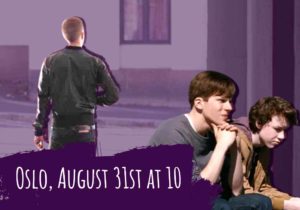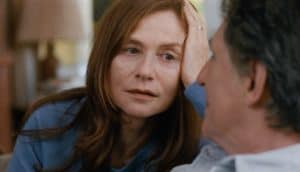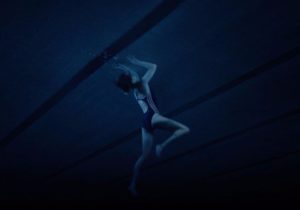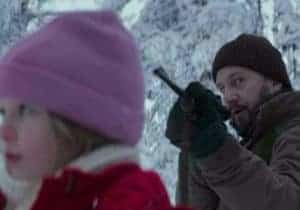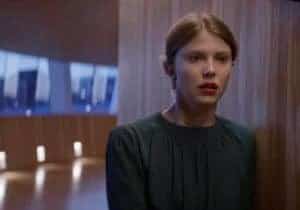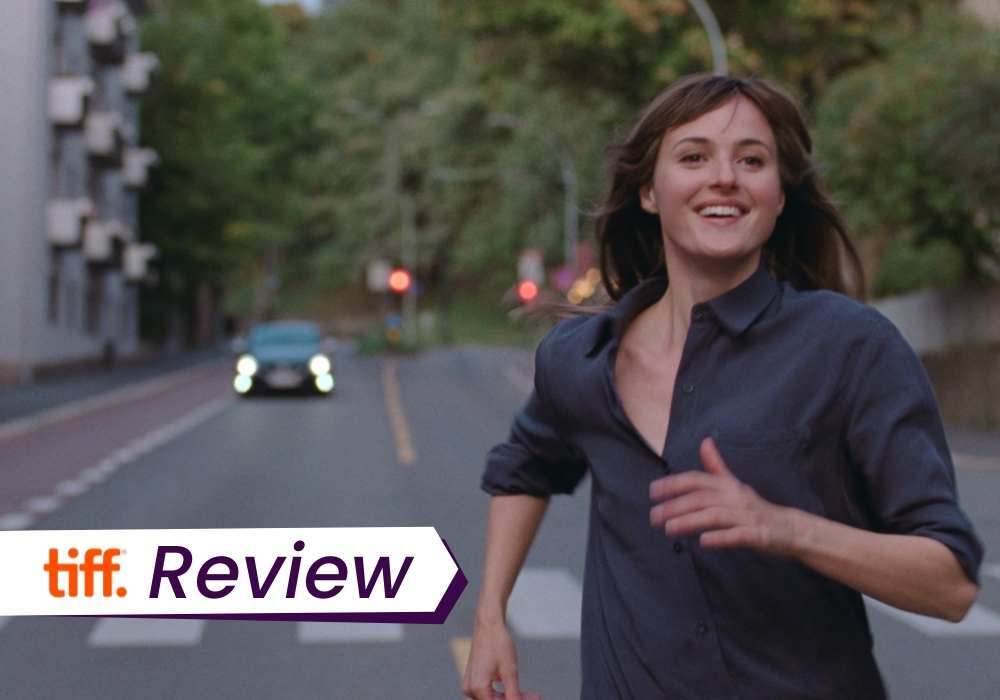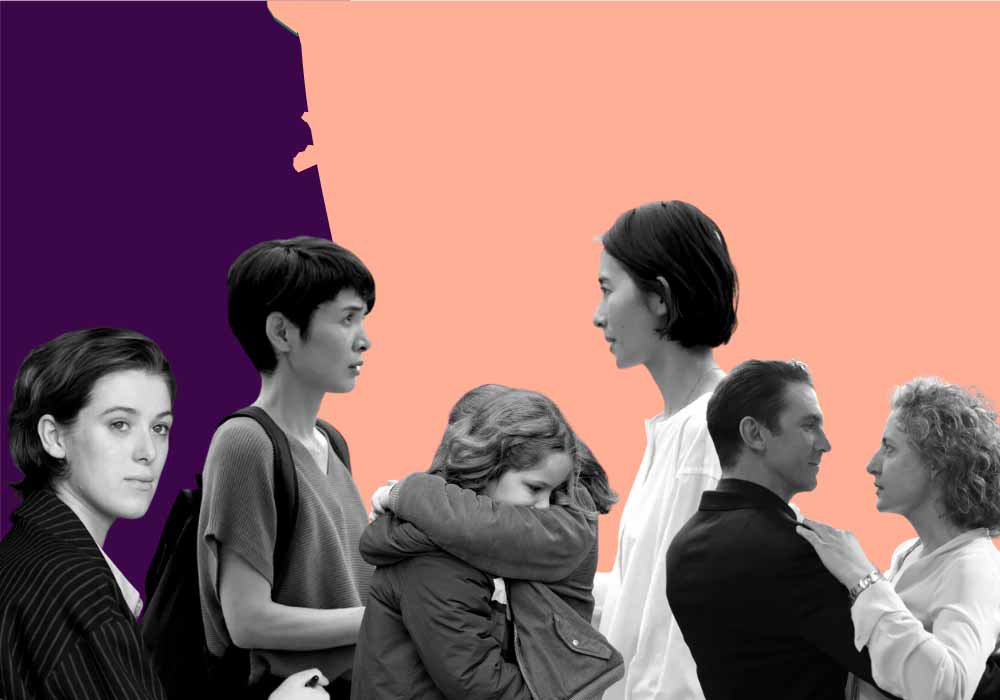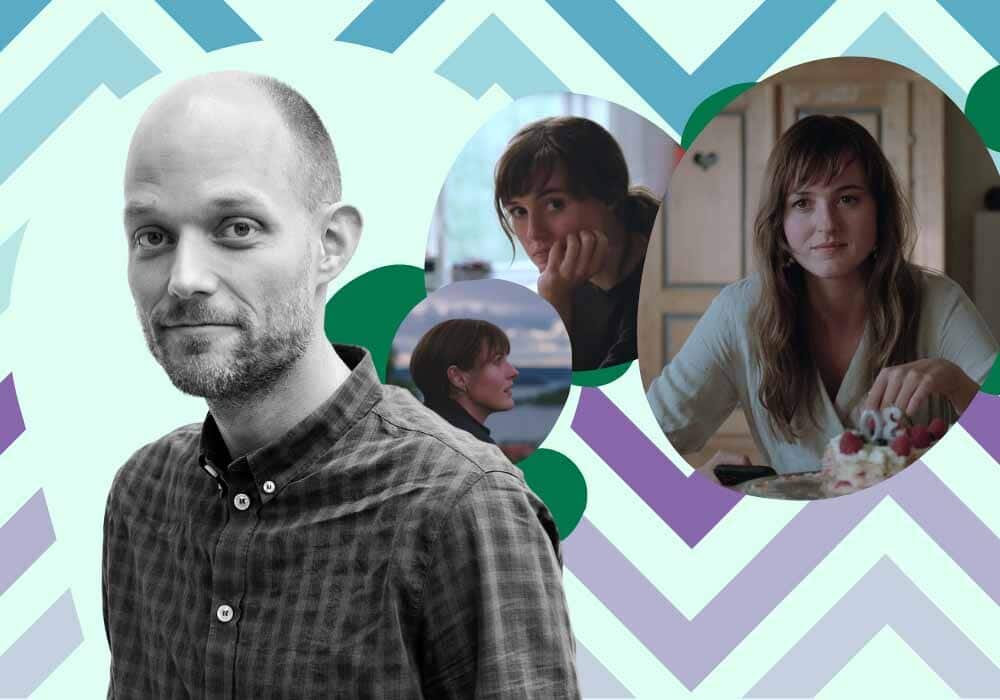The most in-depth resource on director and writer Joachim Trier in the English-language and on the internet (or anywhere else).
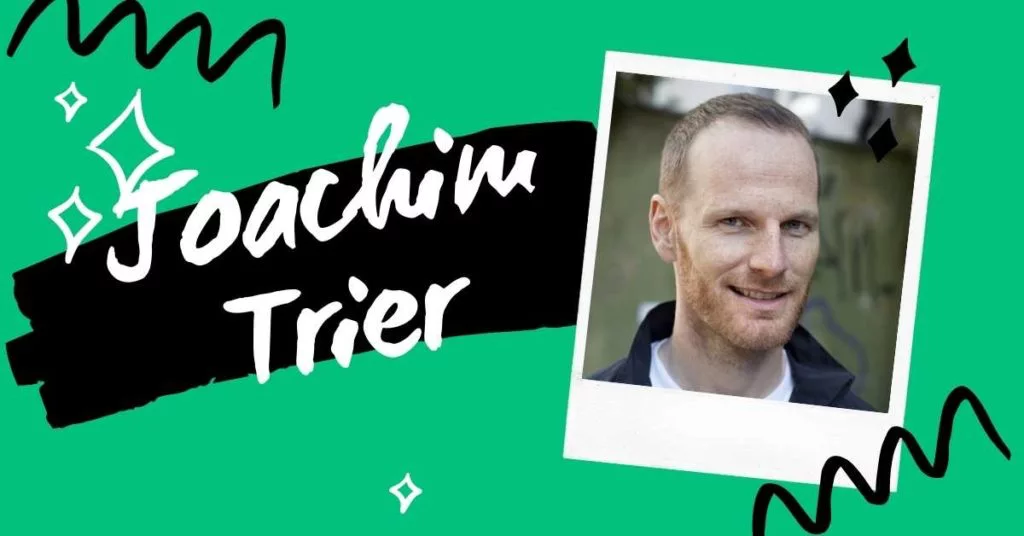
Joachim Trier: a comprehensive guide to his films
Since 2015, Seventh Row has been committed to becoming the best source for criticism on and information about the films of director Joachim Trier.
Pre-order the first book ever written on Trier’s films, and get The Audio Commentaries for his first four feature films (Trier has never recorded any himself).
About Joachim Trier
(Source: Seventh Row’s interviews with Trier and his team)
Norwegian writer-director Joachim Trier has proven himself a master of his craft over the course of just five feature films. These are: Reprise (2007); Oslo, August 31st (2011); Louder Than Bombs (2015); Thelma (2017); and The Worst Person in the World (2021). His first documentary, The Other Munch (2018), was co-directed with his brother, Emil Trier. Thus far, The Other Munch has had one international screening in New York City.
What makes a Joachim Trier film?
All five of Trier’s features thus far feature deep psychological insight and empathy. Trier merges multiple styles and influences, ranging from social realism to the French New Wave. His films are characterized by their unconventional use voiceover, montage, subjective soundscape, complex non-linear editing, and mise en scene to depict thought processes. In our interviews with Trier and his collaborators, we explore these influences and approaches and how Trier collaborates to make these a reality.
Notable quotes
“People talk about the death of cinema, and they talk about the death of the novel. The novel has reinvented itself and changed form and been experimental and, therefore, has survived. I think movies should be inspired by that — the spirit of the possibility of the dramaturgy not being one thing. The dramaturgy or the structure of your telling is up for grabs, and it’s personal.” – Joachim Trier, Seventh Row Louder than Bombs Interview Part 1
“How to show thinking in cinema, it’s something I’m really interested in. I get so pissed when people say, “Oh, thinking, that’s for the novel. Cinema is about the exterior”. I disagree. Film can be incredibly subjective.” – Joachim Trier, Louder Than Bombs Interview Part 2
Seventh Row is the source for information on Joachim Trier
Yet very little information is currently publicly available about Trier. This includes basic biographical details to analysis on his ongoing collaborations. His most important collaborators include co-writer Eskil Vogt, cinematographer Jakob Ihre, editor Olivier Bugge Couttée, and actor Anders Danielsen Lie. While Trier has done interviews with the press about each of his films, there is limited information on his process. Existential detours is the first and full-length study of Trier’s work. The forthcoming ebook offers 360-degree view of his process through his eyes and his collaborators.
To our knowledge, Seventh Row’s two Special Issues on Trier’s most recent films — Louder Than Bombs and Thelma — are the most in-depth critical studies of these films, which include conversations with Trier and his collaborators about their inspirations, influences, and approach to making these films a reality.
Notable quotes
“People talk about the death of cinema, and they talk about the death of the novel. The novel has reinvented itself and changed form and been experimental and, therefore, has survived. I think movies should be inspired by that — the spirit of the possibility of the dramaturgy not being one thing. The dramaturgy or the structure of your telling is up for grabs, and it’s personal.” – Joachim Trier, Seventh Row Louder than Bombs Interview Part 1
“How to show thinking in cinema, it’s something I’m really interested in. I get so pissed when people say, “Oh, thinking, that’s for the novel. Cinema is about the exterior”. I disagree. Film can be incredibly subjective.” – Joachim Trier, Louder Than Bombs Interview Part 2
Plaudits for Joachim Trier’s films
Trier is one of the most exciting filmmakers shaping the landscape of modern cinema. His first feature, Reprise, won the Toronto International Film Festival’s esteemed Discovery Award. His next two films both premiered at the prestigious Cannes Film Festival, the most prestigious film festival in the world. Oslo, August 31st screened in the Un Certain Regard sidebar. Louder Than Bombs was upgraded to the elite Official Competition.
Both Reprise and Thelma were Norway’s submissions for Best Foreign Language Film at the Oscars. Trier has picked up Best Director from the Amanda Awards — Norway’s Oscar equivalent — for his first three features. In 2013, he was featured in the New York Times’ as one of 20 Directors to Watch. He has repeatedly won top honours at the Amanda Awards and Critics Awards.
Plaudits for The Worst Person in the World
The Worst Person in the World received two Oscar nominations in 2022. These Oscar nominations were for Best International Film and Best Original Screenplay (Eskil Vogt and Joachim Trier). The Worst Person in the World also received BAFTA nominations for Best Film Not in the English Language and Best Leading Actress (Renate Reinsve). It was nominated for 11 Amanda Awards including Best Director, Feature, Screenplay, Actress, and Supporting Actors.
Joachim Trier’s Key Collaborators
Co-writer Eskil Vogt
Eskil Vogt is a Norwegian writer and director; his first feature was Blind. Vogt has also co-written all of Joachim Trier’s short and features with him. For each film, Vogt and Trier discuss the ideas for a script, and then Vogt writes up the script himself. Vogt remains involved in the entire process of making the films, from casting to the final edit. He no longer attends the shoot (as he did for Reprise). Vogt and Trier are close friends, and they remain in close contact throughout the shoot. (Source: Seventh Row interview with Eskil Vogt)
Cinematographer Jakob Ihre
Swedish cinematographer Jakob Ihre met Trier at film school. They collaborated on Trier’s first four features and all of his shorts. Ihre has shot films and commercials in Scandinavia and the US, including The End of the Tour (2015). He received a BAFTA for his work as the cinematographer on the TV series Chernobyl (2019).
“He’s very unique, Joachim, very talented with a very clear vision, very knowledgeable and very hands on. He is the textbook definition of a film director. He directs everyone – not only the actors but all the department heads. But he still remains a wonderful team player and collaborator who makes everyone feel like it’s their film, too. I find that the crews on his sets really, really care about the film! The films become very personal, not only because of the scripts, but also because of the making of it. We really feel we are part of the making of the film”. – Jakob Ihre
Actor Anders Danielsen Lie
Anders Danielsen Lie made his first film as a child (the unexpected hit Herman (1990)). His mother is Norwegian actress Tone Danielsen, who actually plays his mother in Reprise. Reprise was the first film he made as an adult. Trier and Vogt wrote Oslo, August 31st specifically for Lie to star in. Lie has since worked in film and television in Norway, France, and the US.
Notable quotes
“I think [Joachim] believes that the more complexity, the better. With other directors, I don’t always think that that’s a good idea, to aim for more complexity or ambivalence. But with him, it works.” – Anders Danielsen Lie, Seventh Row interview
“Joachim is very involving. He likes to direct a lot. There is almost no other director I could discuss psychological issues in depth with on set. It’s just not so productive. You have to find solutions. But with Joachim, it’s just the way that we like to work together. He’s also not afraid of being very analytical and very honest about almost everything. You can go really deep between two takes.” – Anders Danielsen Lie, Seventh Row interview
For the 10th anniversary of Oslo, August 31st, Lie talked to Seventh Row about his work on that film. Lie has appeared in all three films in Joachim Trier’s Oslo Trilogy. Most recently, he co-starred in The Worst Person in the World.
Joachim Trier’s short films
Trier has directed two short films: Still (2001) and Procter (2002). Unfortunately, neither are available online or in North America.
Notable quotes
“My early short films are very meticulously spatially thought out. Doing a feature like Reprise, I couldn’t control it all. That was a liberating thing. I had to learn to be more intuitive. Also, I was working more with actors, and that challenges the plan in a very positive way.” – Joachim Trier, Louder Than Bombs Interview Part 1
Joachim Trier’s commercials
In addition to his work in film, Trier has directed several commercials for Scandinavian brands. These include: SpareBank 1, the Norwegian Lotto, Hafslund, Elko, and Involveyourself.com. These feature similar approaches to dense editing and montage as he has explored in his films. You can watch his commercials here.
Reprise (2006) – directed by Joachim Trier
Joachim Trier’s feature debut, Reprise, is an ambitious coming-of-age story centred around two protagonists. It marked the beginning of an ongoing feature film collaboration with his key technical team. Anders Danielsen Lie’s performance was a revelation. It marked Trier as a director with a keen eye for spotting acting talent. The young, relatively untested leads in Louder Than Bombs (Devin Druid) and Thelma (Eili Harboe) proved also particularly talented.
In our Special Issue on Thelma, Alex Heeney wrote about the connections between Reprise and Oslo, August 31st, and how these bear a resemblance to the connections between Louder than Bombs and Thelma.
Notable quotes
“Actors, skilled actors, are open to being — I wouldn’t use the world “manipulated” but — stimulated to try to reach something that ultimately they have to bring. This is the whole interplay between directing and acting. You can never micromanage performance. You’ve got to trust. In this case, I had some amazing actors. I couldn’t be happier.” – Joachim Trier, Louder Than Bombs Interview Part 1
Oslo August 31st (2011) – directed by Joachim Trier
This film put Trier on the international film scene in a major way after premiering at the Cannes Film Festival. Many critics cite it as one of the best films of the 21st century.
In her essay, Heeney explains, “Oslo, August 31st is like a feature-length expansion of the secondary protagonist in Reprise, Philip (Anders Danielsen Lie). Philip was a brilliant writer who lost his mind when he achieved success, becoming suicidal. Reprise focused on the consequences of Philip’s artistic ambition. Oslo, August 31st told the story of a similarly talented writer, Anders (again played by Lie). But Oslo looked at how he dealt with his depression and suicidal feelings after destroying his career.”
Louder Than Bombs (2015)
Joachim Trier’s sublime English-language debut, Louder Than Bombs, is an engrossing and empathetic look at a family recovering from trauma. Our Special Issue on Louder Than Bombs features a two-part interview with Joachim Trier and an interview with cinematographer Jakob Ihre. It also features an essay on the film’s non-linear structure, and an essay comparing themes in Louder than Bombs to those in Oslo, August 31st . Together, these reveal Trier’s influences, inspirations, preoccupations, and collaborations. They also illuminate what makes Louder Than Bombs one of the best films of the 21st century.
Notable quotes
“Oslo, August 31st deals with addiction and depression. I would certainly say these are elements in the mother character in this one. But the point of view is very much more from the family.” – Joachim Trier, Seventh Row Louder than Bombs Interview Part 1
“I don’t want to take voiceover as an easy cop-out just to tell something that I’m not representing visually. It always has to stand in contrast, to show something other than the visual, to be creatively interesting. So we were doing all kinds of weird voice-over tricks here and there.” – Joachim Trier, Louder Than Bombs Interview Part 2
Seventh Row’s coverage of Joachim Trier’s Louder Than Bombs
Thelma (2017)
Thelma marks Trier’s first foray into genre territory. Our Special Issue on Thelma reveals that the film still features similar techniques and themes as Trier’s previous work. To write Thelma, Trier and Vogt shifted their process by starting with images rather than themes and characters. Still, the approaches to shooting and filmmaking are remarkably similar even though Thelma is a more overtly stylized film.
Thelma is also Trier’s first film without any voiceover. “In Louder Than Bombs, Jonah (Jesse Eisenberg) was the only major character who did not have a voiceover. Fittingly, Thelma is a feature-length exploration of the parent-child relationship that is loving but so close it was toxic. Both Jonah and Thelma spend their respective films learning to detach from a dependent relationship with a parent. Thelma’s devoutly Christian father provides her with tenderness and support. But his attention is subtly controlling and isolates her from her peers. Thelma’s outsize need for his approval causes her to suppress her romantic feelings for a female classmate, ultimately wreaking havoc.”
Case study on Thelma in Beyond Empowertainment
In our ebook on feminist horror, Beyond Empowertainment, there is a full case study to looking at why Thelma is a feminist horror film. This includes essays on the film and interviews with Trier, Vogt, and Ihre.
Read free excerpts from the Thelma case study in Beyond Empowertainment
The Worst Person in the World (2021)
The Worst Person in the World premiered in the Official Competition at the Cannes Film Festival in July 2021. This is the second time Trier has been in the Official Competition. Lead actress Renate Reinsve won the Best Actress award for her work on the film. Frequent Trier collaborator Anders Danielsen Lie also appears in the film.
“Divided into twelve chapters, a prologue, and an epilogue, The Worst Person in the World tracks a few years in the life of Julie, a woman in her early thirties, as she grapples with who she is, what career she wants, and what she wants in life. When I first interviewed Joachim Trier about Louder Than Bombs, he talked about how he thinks that cinema should be like the novel, and this film’s structure makes that intention more obvious than any of his previous films. Instead of the multiple (and sometimes blurred) perspectives of Louder Than Bombs (2015), an intricately structured film that keeps its cleverness close to the chest, The Worst Person in the World offers a more direct roadmap for the viewer by laying out the chapters.” Read the full review
Read articles on The Worst Person in the World
FAQs about The Worst Person in the World
The answers to these questions are largely based on our extensive interviews with the entire filmmaking team. These will appear in full in our forthcoming ebook on Trier’s work, which you can pre-order today. Some of these insights also appear in The Joachim Trier Audio Commentaries which are available now.
Woody Allen’s Annie Hall has been a key reference for Trier and Vogt throughout their career, and they bring the same sensibility for an inventive rom-com to The Worst Person in the World. The dress that Julie wears at the beginning of the film is actually modeled after a dress Annie Hall wears in that film. When preparing to write the film, Trier and Vogt revisited films such as The Philadelphia Story, Holiday, Eat Pray Love, and Paul Mazursky’s films. Trier also always has Bergman, Antonioni, Bresson, and Ozu on his mind, and has talked about them in previous interviews.
Reinsve’s first screen role was in Oslo, August 31st, in which she shared several scenes with Anders Danielsen Lie and shot for nine days though had few lines. Reinsve played the twentysomething date of Anders’s friend. She has since worked in Norwegian TV and theatre, as well as in a few films. The Worst Person in the World was written for her specifically.
At Cannes 2021, Reinsve won the Best Actress Award for her performance in The Worst Person in the World which quickly catapulted her into international fame.
Download our full interview with Reinsve FREE from the forthcoming book Existential detours: Joachim Trier’s cinema of indecisions and revisions.
Anders Danielsen Lie is an actor who has worked with Joachim Trier on all of the films in the Oslo Trilogy: Reprise, Oslo, August 31st, and The Worst Person in the World. He became an indie cinema darling after his incredible performance in Oslo, August 31st (which he discussed here), appearing in many French films, such as This Summer Feeling, Night Eats the World, and Fidelio: Alice’s Journey. He became more internationally known after his work on 22 July, which he discussed with Seventh Row here.
In 2021, he had two films premiere in Competition at the Cannes Film Festival, Bergman Island and The Worst Person in the World. He also moonlights as a medical doctor, and he discussed the connections between his two professions in our interview.
FAQs on the making of The Worst Person in the World
Production on The Worst Person in the World began in early 2020 in Oslo, but was shut down after just a few days because of the pandemic. The shoot resumed in August 2020 and wrapped at the end of October 2020.
The scene was shot entirely using only practical effects. Here’s Renate Reinsve on the filmmaking process: “The mushroom scene was also very technical. When I fell on the carpet, they didn’t put me in CGI or special effects. It was a mattress with a carpet sixty meters behind me and two guys running and smashing it into my back. Two people had to hold me on my hips under the frame so that I wouldn’t like [boom]. I love the really physical stuff like that.”
Here’s production designer Roger Rosenberg on how this scene was accomplished: “That was a really big challenge. That was also one reason to make Eivind’s apartment in the studio, because that allows us to remove the wall or parts of the set. We shot all the scenes in his apartment, and then we started moving away some walls and made a hole in the wall to get the beginning of when we see her feet and she falls. And then, I made a big rig with a huge rug that was on a track. So actually, she took a few steps backwards and we had this big dolly push in this big rug with some padding behind, so it looks like she’s falling, but she’s actually kind of standing, and the rug comes up to her. [The black room she enters is] just an empty space with a rug.”
Here’s Renate Reinsve on her experience: “Of course, Joachim wanted to do all of the big epic scenes — like the running through the city frozen scene — old school with no special effects. It was a big process of closing down the whole city and running. We didn’t have much time. It’s the busiest place in Oslo, so it was hard to concentrate on doing it. It was very technical. He was running after me to do it at the same pace and at the same distance. Acting and running at the same time was challenging. Kasper wasn’t the one shooting that scene [the part where she is running], so there was suddenly a new guy that I had to dance with, and that was very challenging. But it turned out nice.”
To shoot the ‘perfect date’ between Julie and Eivind actually took several days. According to cinematographer Kasper Tuxen, “I think we must have shot it over something like eight days. When it gets dark and they run to the top of the park where they kiss… we were there twice. Once going into evening when [Julie and Eivind] are deep in conversation, and then as morning breaks.”
Sentimental Value (2025?)
Joachim Trier’s follow-up to The Worst Person in the World will find him re-teaming with Renate Reinsve for the film Sentimental Value.
According to Variety, Sentimental Value “will follow Nora (Reinsve), an actor, and her sister Agnes, who are grieving the loss of their mother while their father Gustav reappears in their lives after a long absence. Gustav, a once-celebrated filmmaker, has written a script for a comeback movie and offered the main part to his daughter Nora, but she categorically refuses the role. During a career retrospective in France, Gustav meets an adoring Hollywood star and offers her the part intended for Nora. When the film starts shooting back home in Norway, Gustav seizes the opportunity to repair his bond with Nora and her sister.”
The film will shoot in August 2024 in Norway, Germany, and France. Trier is likely aiming for a May 2025 Cannes premiere.
FAQs about Joachim Trier
Joachim Trier has directed five narrative feature films — Reprise (2007), Oslo, August 31st (2011), Louder Than Bombs (2015), Thelma (2017), The Worst Person in the World (2021) — and one medium-length documentary (co-directed with Emil Trier), The Other Munch.
Trier grew up in and lives in Oslo, Norway, though his father is from Denmark.
Trier has co-written all of his narrative features with Eskil Vogt, worked with sound designer Gisle Tveito, editor Olivier Bugge Couttée, and composers Ola Fløttum and Torgny Amdam. Cinematographer Jakob Ihre shot Trier’s first four features; Kasper Tuxen shot The Worst Person in the World. He has made three features with actor Anders Danielsen Lie, costume designer Ellen Dæhli Ystehede (Oslo, August 31st, Thelma, The Worst Person in the World) and production designer Roger Rosenberg (Reprise, Thelma, The Worst Person in the World).
The Oslo Trilogy refers to Joachim Trier’s three Oslo-set films about bourgeois Oslo natives who are members of the intelligentsia: Reprise (2006), Oslo, August 31st (2011), and The Worst Person in the World (2021). All three films were written by Eskil Vogt in collaboration with Joachim Trier and feature actor Anders Danielsen Lie. The films share a similar milieu and echo each other’s themes and images.
Joachim Trier’s films tend to be internal stories about characters figuring out who they are, going through existential crises, and finding a way to become independent from their parents. Mental illness, suicide, and depression were all focuses of his first three films.
Toxic if loving relationships between parents and their children have been explored to varying degrees in Oslo, August 31st, Louder Than Bombs, Thelma, and The Worst Person in the World. More broadly, all of his films are studies of loneliness, friendship, and to varying degrees, romance.
Trier has talked repeatedly about his interest in depicting thought patterns on screen, which is part of why he often uses montage. His stories tend to be about somewhat passive, observational characters undergoing internal shifts.
Joachim Trier will re-team with Renate Reinsve for Sentimental Value, which will shoot in August 2024. Expect to see it turn up at Cannes 2025 (if all goes well).
